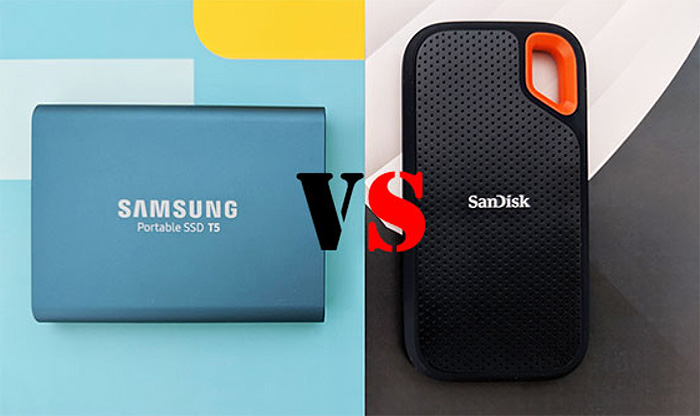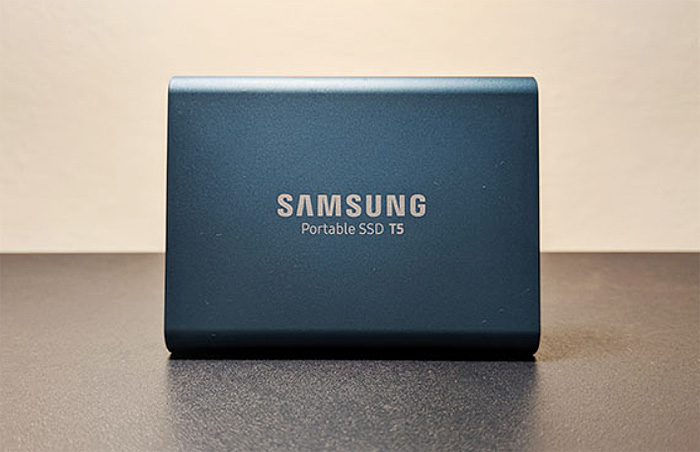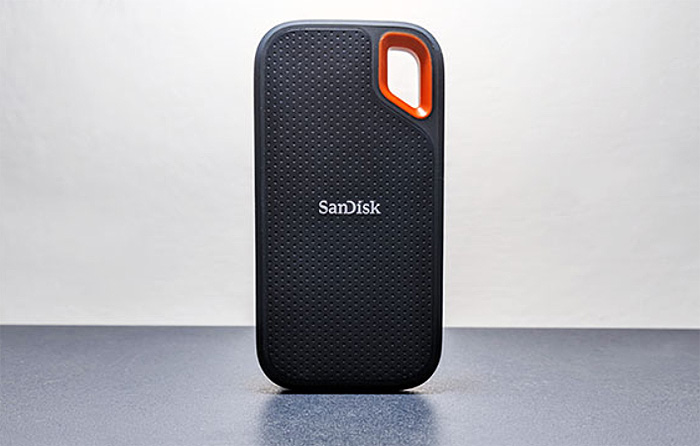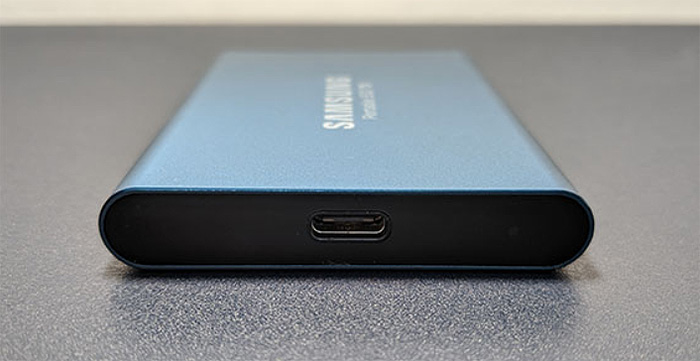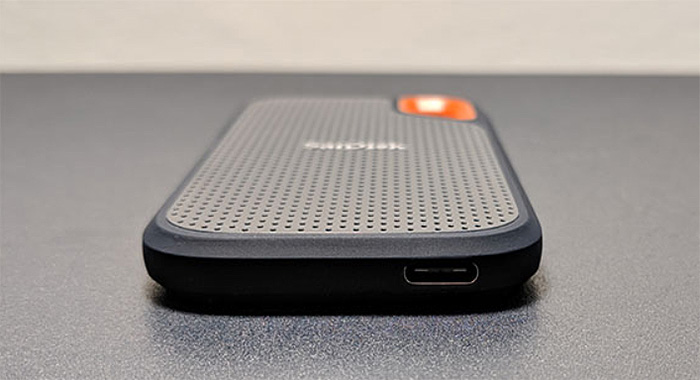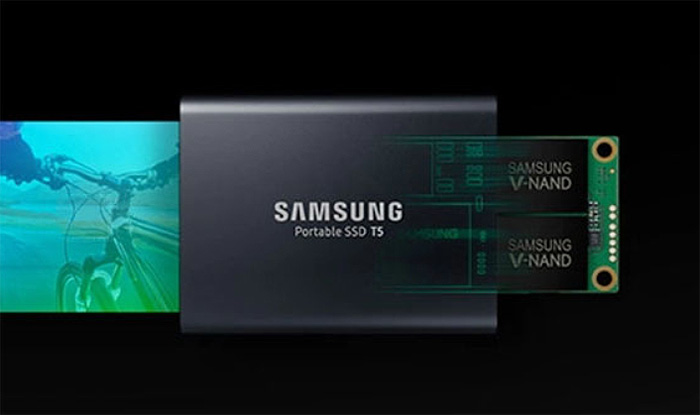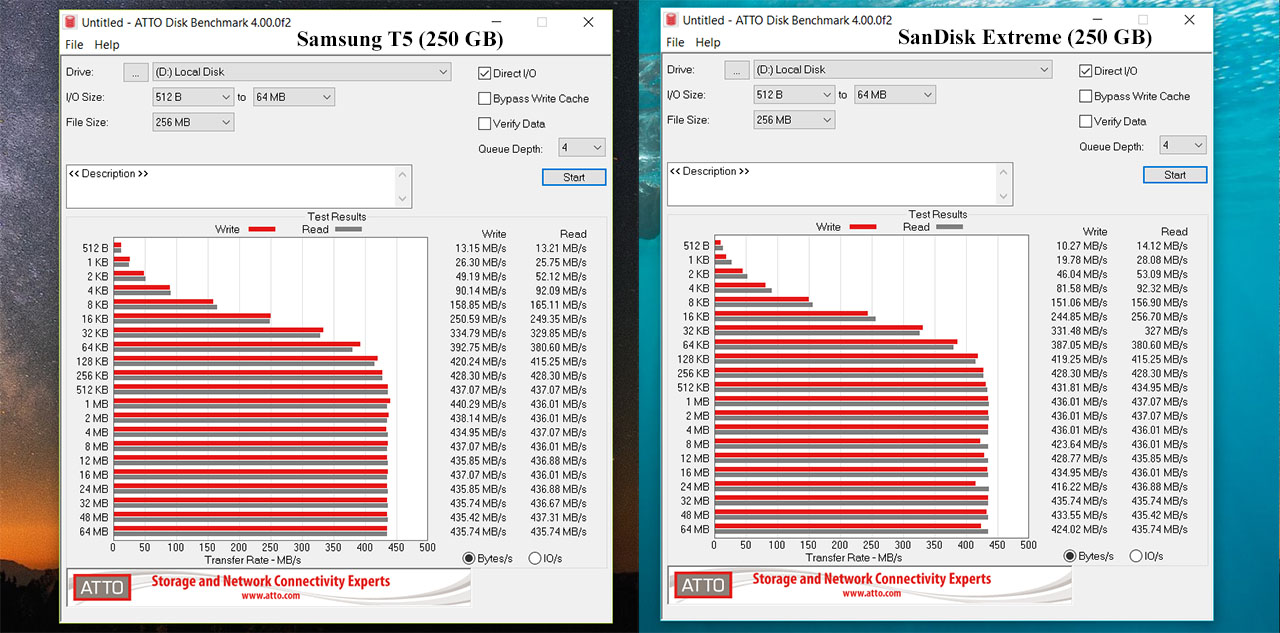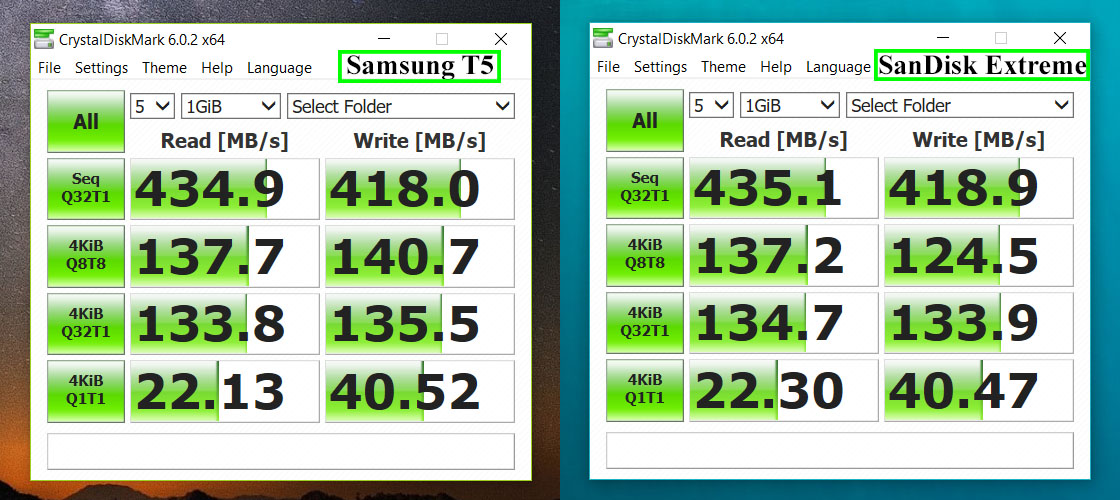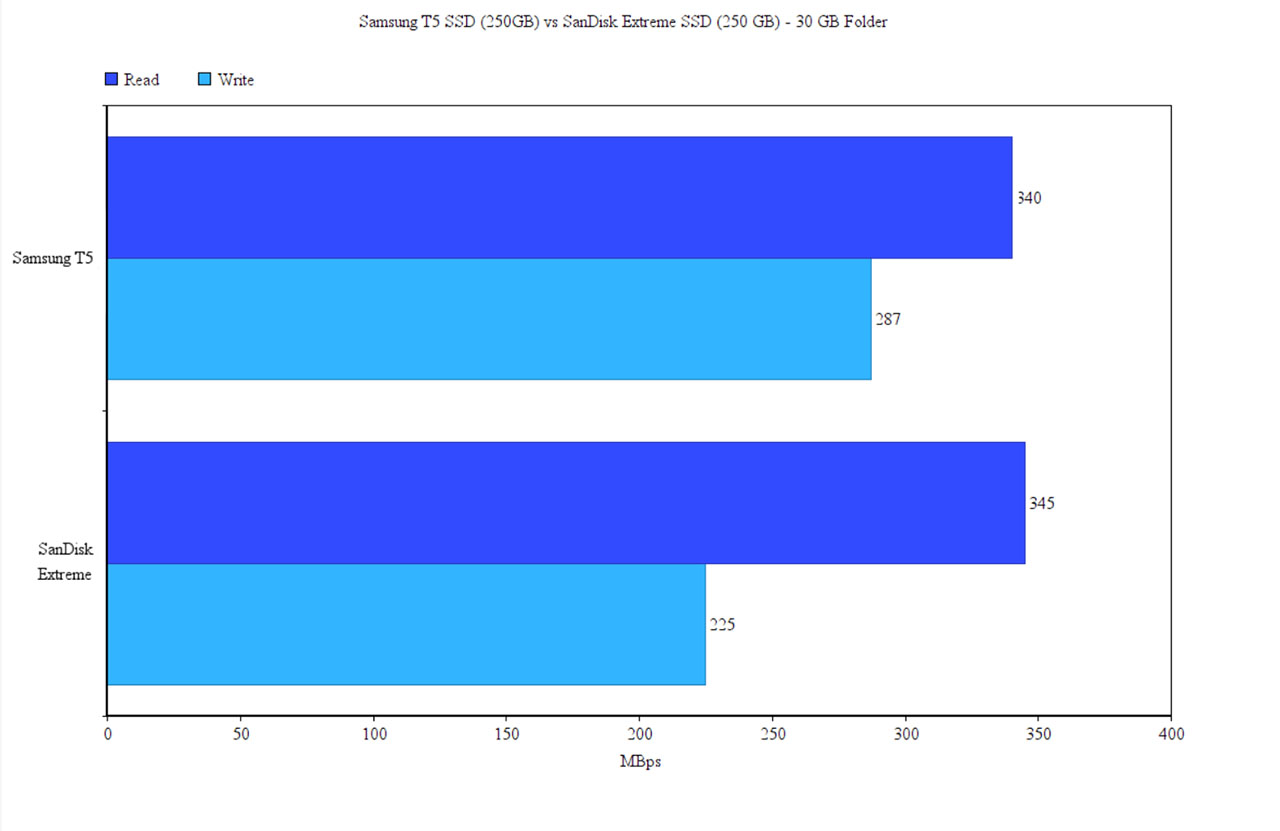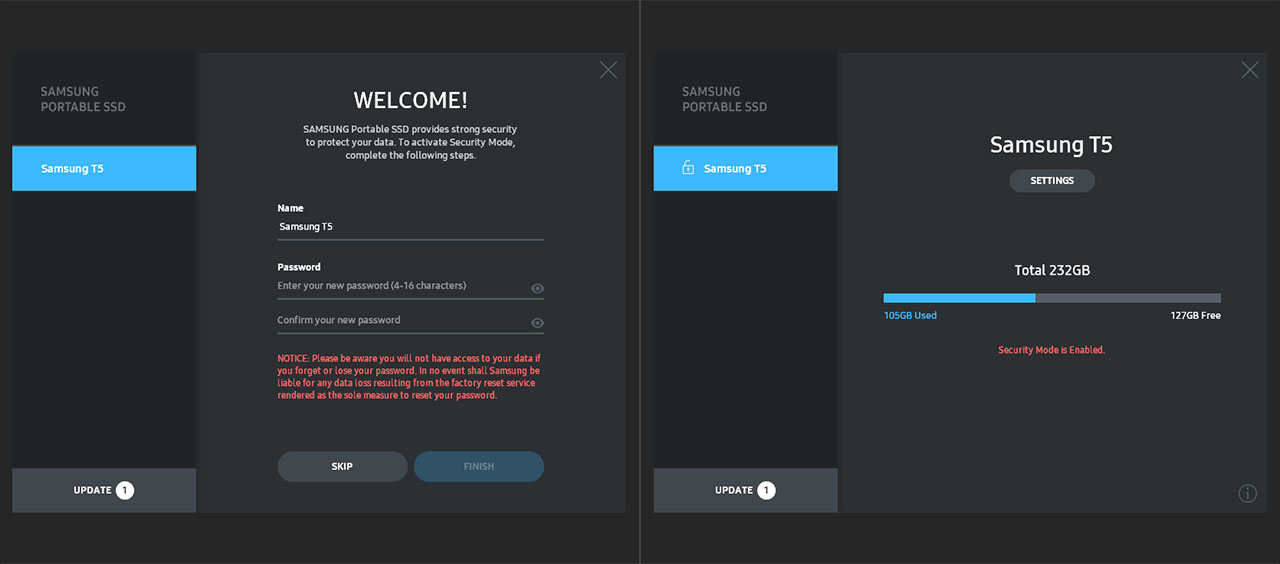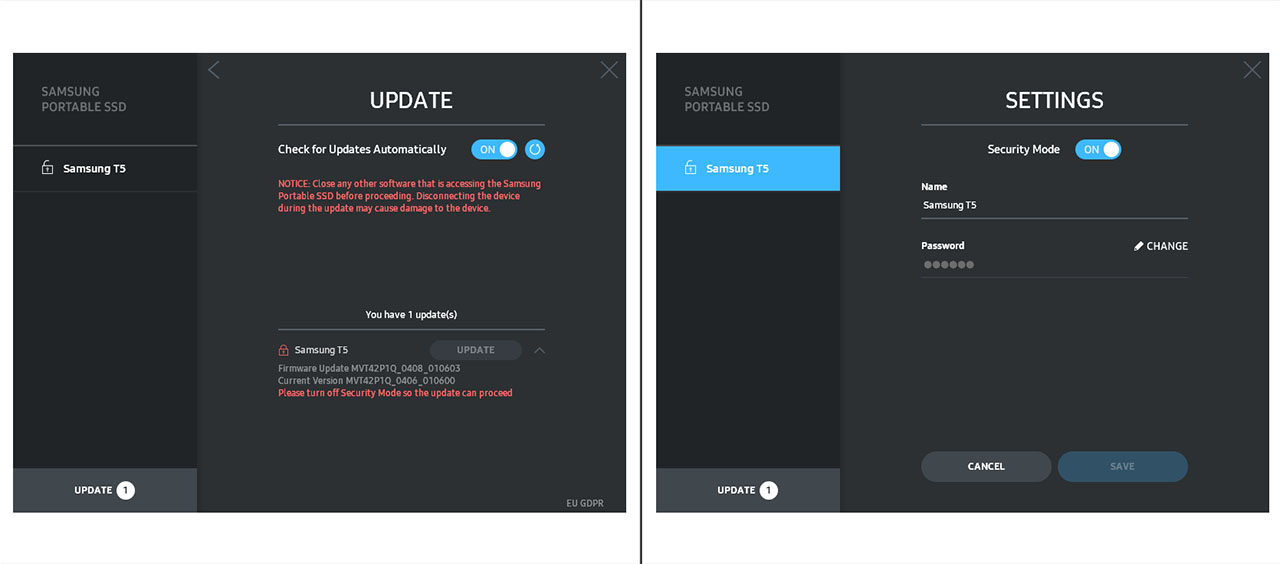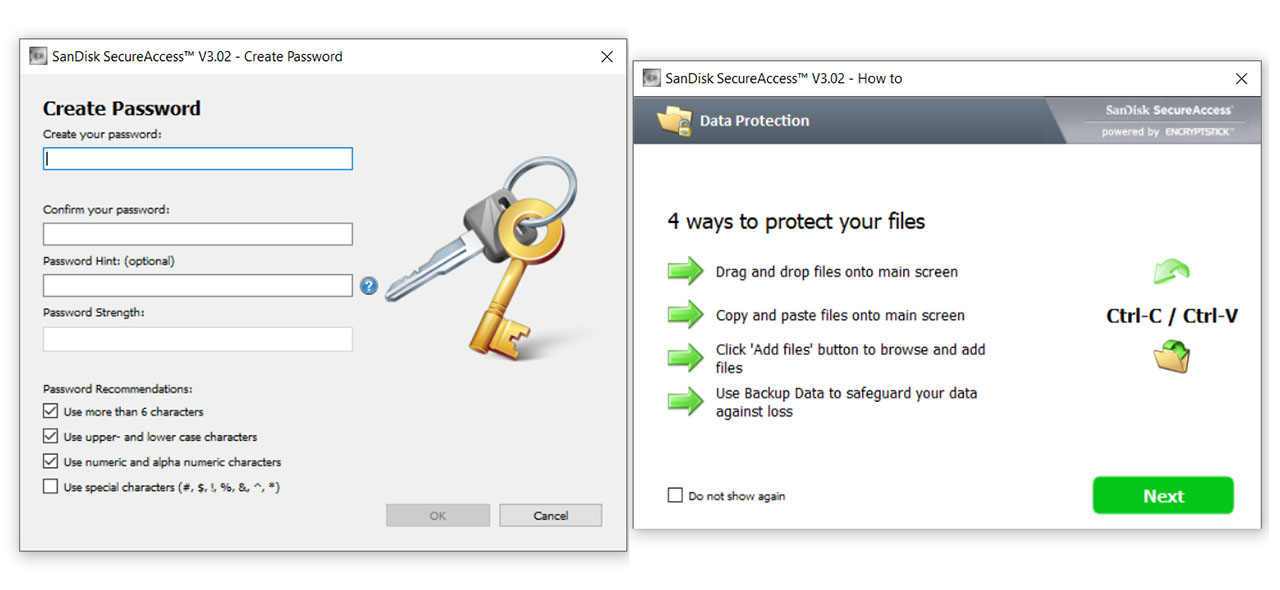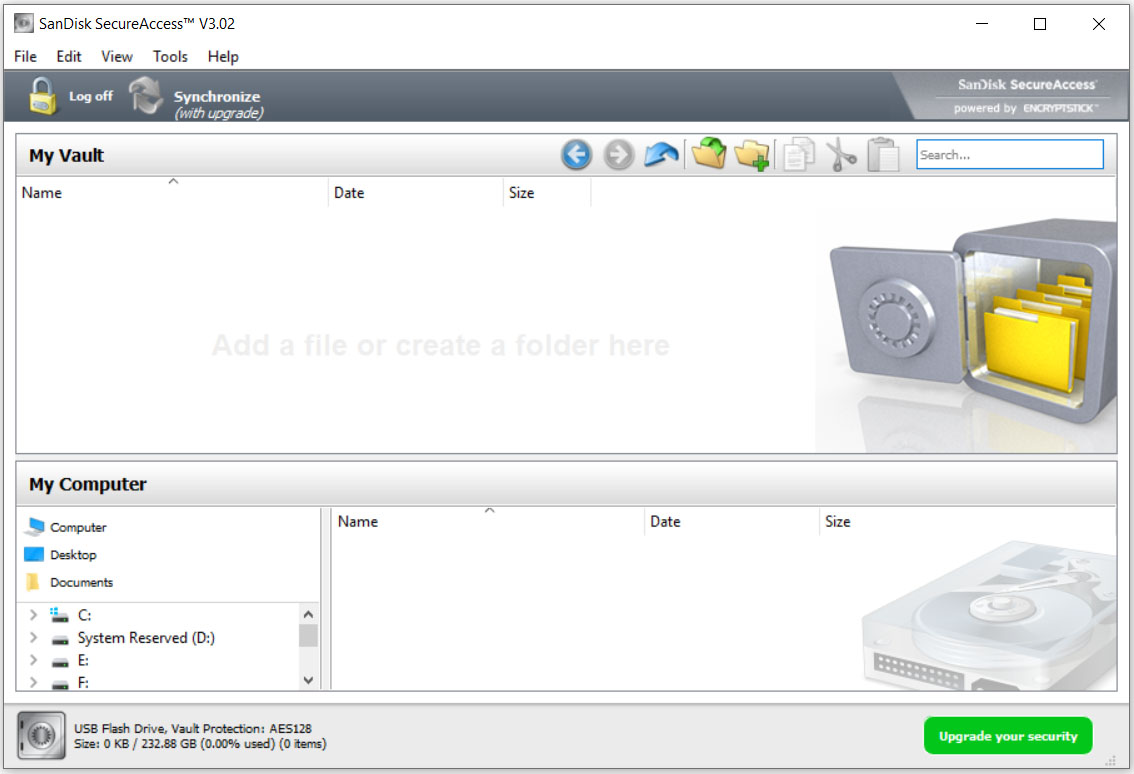The Samsung T5 and the SanDisk Extreme are two of the most popular external SSDs available on the market (right next to the G-Drive, Seagate and WD My Passport), both focusing towards offering the best portability, high speed performance, a better level of security (AES encryption), and an easy to use software; furthermore, with the current trend of falling cost, neither of the two devices have premium prices. And this is good news especially for those that were constrained to pay big money for a few more GB on their laptops (yes, I’m talking mainly about MacBooks). Samsung has been dominating the SSD market for a while now, so the fact that the T5 is a lot of the times considered the best portable SSD from the cost to performance perspective comes as no surprise since similarly to the M.2 and the SATA SSDs, they once again got the formula right.
| Samsung T5 SSD | |
|---|---|
| Amazon.com | Check Offer |
| SanDisk Extreme SSD | |
|---|---|
| Amazon.com | Check Offer |
But, the competition never sleeps and Western Digital, another giant in the storage market has released last year the SanDisk Extreme SSD series which matches the T5 in features (it also uses the 3D / VNAND Flash technology for a better performance and longer life span), but it focused a lot more towards the portability factor, therefore offering a great alternative for those that found the T5 less suitable for outdoor adventures. Considering that the Samsung T5 and the SanDisk Extreme will most likely be the top options for a while especially for photo / video storing, but also for backup and general use, I decided to test them and see which can be regarded as the better external SSD.
ALSO CHECK OUT: SAMSUNG 850 EVO VS SAMSUNG 860 EVO
Design
The external storage products come in many forms, ranging from the relatively large NAS devices which have sacrificed portability for the storage flexibility and then there’s the USB drives and the external SSDs that are portable and a lot cheaper. The Samsung T5 and the SanDisk Extreme SSDs are definitely bigger than your average flash drive (the Patriot USB drives are among the few that are trying to blur that line), but the built quality and the speed performance is significantly better. That being said, the Samsung T5 features a small rectangular case made of a single aluminum piece which curves around the internal hardware, allowing only two pieces of plastic on the lateral sides.
The SSD measures 2.91 x 2.25 x 0.41 inches and weighs 1.79 ounces, so it can easily fit in a pocket, but be aware that because of its soft finish, it can be a bit slippery (initially, the T5 had a blue case if you went for the 250 and 500 GB variants and a black case if you opted for the 1 or 2 TB variants – in the meantime Samsung has also added red and gold).
The SanDisk Extreme went with a very different design approach, featuring a narrower, but slightly longer case (it measures 3.78 x 1.95 x 0.34 inches) and, because it only weighs 1.37 ounces (it’s a lot more lightweight than the T5), it can give that surreal feeling that you’re not really holding a powerful external SSD in your hand. While Samsung has covered its T5 line mainly with aluminum, SanDisk’s case is made out of hard plastic, on one side covered by a soft finish (it’s a dust magnet), while the other has a rubber-like finish, making sure that it won’t easily slip out of your hand (or desk). The entire case is black, but the manufacturer has added a relatively large cut-out which draws your attention especially because it is surrounded by an orange plastic loop (it’s a nice addition if you want to add it to your keychain).
When put next to the Samsung T5, it’s clear that SanDisk wanted to let you know that its SSD is more focused towards the protection against drops and it is true that the SanDisk Extreme will most likely survive unscathed from any type of falls thanks to its rubbery case, but don’t be fooled by the aluminum body of the T5, because I’ve been using it for almost a year and during this time it has survived multiple tumbles on the concrete floor and lots of travel – all that valiantly (for additional protection, you can purchase a leather pouch or use a skin). And that’s really the nature of the SSDs, since, unlike the traditional HDDs, these lack any spinning platters, therefore besides being lighter, they’re also stronger. SanDisk went a step further, so its disk is IP55 rated which means that the device is dust protected and it will survive against water jets directed towards the enclosure.
One significant difference between the two disks is the heat management: the Samsung T5 remained cool most of the time it was connected to my PC (it got warmer after data was transferred for a longer period of time), but SanDisk got significantly warm immediately after I connected it to a PC (close to the USB port) and it remained this way for the entire time it was connected.
Both the SanDisk Extreme and the Samsung T5 have a USB 3.1 Gen2 Type-C port (10Gbps) for connectivity purposes, but the T5 also comes with a small blue LED which lets you know when the portable SSD is connected (draws power) and when data is being received or transmitted (the blue LED will flash) – I would have enjoyed a similar approach from SanDisk as well.
Note: The Samsung T5 comes with two USB cables, one Type-C to Type-C and the other Type-C to Type-A, while the SanDisk Extreme comes with a single cable Type-C to Type-C, along with a small Type-A adapter.
Verdict: Samsung is all about simplicity and the small aluminum case of the T5 is perfect for those that want an additional SSD for their laptops or for the people that travel a lot and need a storage device for their photos and videos. The SanDisk Extreme is somewhat smaller and a lot lighter, making it perfect for carrying around (it will even fit in the smaller pocket of your jeans) and its IP55 rating does give it an edge over the T5. At the same time, the T5 runs a bit cooler than the SanDisk Extreme, so this round ends in a tie.
ALSO CHECK OUT: SAMSUNG T5 SSD VS SANDISK EXTREME SSD
Features and Performance
The Samsung T5 External SSD uses the ASMedia ASM235CM Gen 2 SATA III bridge chip and the 64-Layer V-NAND flash (a significant upgrade over the 48-layer TLC V-NAND of the older Samsung T3) which means that this technology stacks 64 layers of 3-bit cells vertically on top of each other maintaining a compact design and more density. Unlike the 850 and 860 EVO which use the SATA III interface (so, it can only go up to 6 Gbps), the Samsung T5 takes advantage of the USB 3.1 Gen 2 Type-C interface, which can go up to 10 Gbps, but the T5 advertises a transfer speed of up to 540 Mbps.
SanDisk has equipped the Extreme SSD in a similar manner, also sporting an ASMedia ASM235CM SATA III bridge chip (along with a Marvell 88SS1074 controller) and it also uses the 64-layer 3D TLC flash technology, which has allowed it to keep that thin profile and up to 2TB of storage available. Furthermore, just like the T5, it takes advantage of the USB 3.1 Gen 2 Type-C interface, but the advertised speed is a bit higher than what Samsung has to offer, topping at 550 Mbps.
I’ve recently had a look at a secure HDD which used hardware-based encryption in order to ensure that the disk would remain impenetrable from both hardware or software-types attacks (I am talking about the iStorage diskAshur 2), so it is important to know that your data cannot be stolen. Neither the Samsung T5, nor the SanDisk Extreme are that fortified, but both offer password protection, the former relying on the AES 256-bit hardware encryption, while the latter uses the 128-bit AES software encryption. Samsung’s hardware encryption is closed source (proprietary) and towards the end of the last year, researchers found that the encryption was faulty, so, because Microsoft’s BitLocker used the SSD’s encryption (instead of its own), it meant that the SSD wasn’t secure in any way. To alleviate this problem, you should install some type of software encryption and not rely on the hardware one. The encryption on the SanDisk Extreme relies on SecureAccess software which creates a separate folder where the private data can be stored and, to access it, you will need to insert a password (the folder can be deleted by anyone that has access to the SSD).
These are the main features of each portable SSD, so let’s see how each performs in a couple of synthetic benchmarks (both drives are formatted to NTFS and I chose the 250 GB variant for each SSD). The CrystalDiskMark 6 synthetic benchmark doesn’t seems to favor any of the two SSDs, since they’re almost evenly matched in every category, but the ATTO Disk Benchmark 4 pushes the Samsung T5 slightly ahead of the SanDisk Extreme in the writing test and keeps it evenly on the read test.
Furthermore, I decided to move a 30 GB folder containing five movie files and, using the Samsung T5 SSD, I measured an average of 340 MBps reading the folder (with a peak of 372 MBps) and an average of 287 MBps writing the folder (with a peak of 327 MBps). Using the SanDisk Extreme (with the same folder), I measured an average of 345 MBps reading the folder (with the peak at 363 MBps) and an average of 225 MBps writing it (with a peak of 229 MBps). As can be seen, the SanDisk Extreme is only slightly faster reading the folder, but it is noticeably slower writing it.
Verdict: The SanDisk Extreme and the Samsung T5 share the same chip and are almost identical in terms of features (except for the encryption type) and, if you were expecting a clear demarcation line between the two in terms of speed, well, the synthetic benchmarks indicate that there is very little difference between the drives and the read / write test (with the 30GB folder) does give the Samsung T5 a slight advantage, so it wins this round, but not by much.
Software
The Samsung T5 comes with a Portable SSD Software compatible with Windows OS, MacOS and Android OS, but, for this article, I used the Windows version which can be downloaded from the official Samsung website. The utility software itself is quite simple, displaying all the connected Samsung T5 drives on the left and the available options on the right side, but, the first thing you’re going to be asked to do is to add a password to protect your data. You can Skip this step, but, if you decide to put a password, make sure you write it down since you will not be able to recover the data if you forget it.
After that’s done, you will see the status of the drive which includes the amount of free and used storage and if the Security Mode is Enabled; further to the top, there’s the Settings icon. As you can see, I had an update available and, in order to apply it, I had to disable the Security Mode (only if you add a password) which can be done by accessing the Settings tab and I had to close any program that used the drive. And that’s pretty much everything that the software has to offer.
The SanDisk Extreme SSD uses the SecureAccess software which is compatible with Windows OS and MacOS – I use the Windows version and, to run it you have to move the utility in the SSD folder. Double click it and immediately you’ll be asked to Create a Password and, on the next window, the tool shows four ways to protect your files (drag and drop them, copy and paste the files, use the ‘Add files’ option or use the Backup Data to safeguard your info). After that, you’ll gain access to the main UI, which doesn’t looks that intuitive and feels like it tries to takes you out of the comfort zone and that’s not really a good thing when compared to the user friendly approach of the T5 software, but it does get the job done. I also haven’t found clear info about how to upgrade the firmware (the PRO version seems to require a bootable drive).
Verdict: The Samsung T5 software is really well done, quickly allowing you to set a password and to update the firmware version and, while the SanDisk Extreme does have a similar tool which encrypts your data and adds a password, it feels less intuitive, so Samsung T5 wins this round.
Conclusion
The more storage we can fit within a smaller case, the more popular the portable SSDs will be and both the Samsung T5 and the SanDisk Extreme are prime examples of how a portable storage device should look and what can the user expect in terms of performance. The two-year old Samsung T5 has almost managed to set a standard for the portable SSDs with its stellar performance, longevity and minimalist design, but the SanDisk Extreme will have more appeal to those that travel a lot and need a rugged device to ensure that the stored data will survive in most cases (the T5 is more suitable for offices, but has proven to be a worthy competitor in terms of ruggedness). The additional software does set the two drive slightly apart, but the writing / reading performance is very similar between the two, so, considering that each drive will do a great job at providing additional storage for your devices, the only significant differentiating factor will be the design preference (and the price, of course).
Note: Both the Samsung T5 and the SanDisk Extreme SSDs come with a three-year limited warranty.
Check the products here:
Samsung T5 SSD:
SanDisk Extreme SSD:

Mark is a graduate in Computer Science, having gathered valuable experience over the years working in IT as a programmer. Mark is also the main tech writer for MBReviews.com, covering not only his passion, the networking devices, but also other cool electronic gadgets that you may find useful for your every day life.

